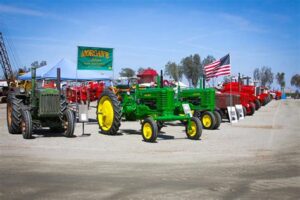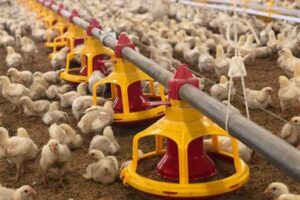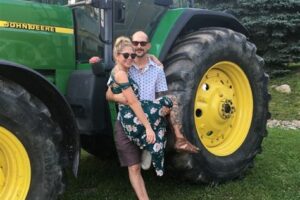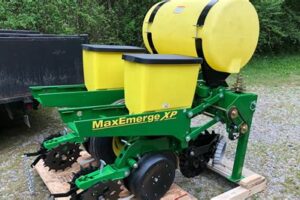Table of Contents
Horse Drawn Farm Equipment is a collection of tools and machinery designed to be pulled by horses for various agricultural tasks. From plows to wagons, this traditional method offers an eco-friendly and sustainable alternative to modern machinery. Explore the benefits and historical significance of horse-drawn equipment for farming purposes.
Horse drawn farm equipment has played a crucial role in the history of agriculture, revolutionizing the way crops are planted, harvested, and transported. With their immense power and sturdy build, horses have been the trusted allies of farmers for centuries, effortlessly pulling heavy machinery across vast fields. From plows to wagons, these equine-powered tools have not only increased productivity but also allowed farmers to cultivate larger areas of land. In this article, we will delve into the fascinating world of horse drawn farm equipment, exploring its evolution, significance, and enduring impact on modern agriculture.
The Evolution of Horse Drawn Farm Equipment
Farming has been a crucial part of human civilization for thousands of years. Throughout history, farmers have relied on various tools and equipment to carry out their work efficiently. One such method that revolutionized the agricultural industry was the use of horse-drawn farm equipment. These sturdy and reliable machines played a vital role in increasing productivity and reducing manual labor on farms. In this article, we will explore the evolution and importance of horse-drawn farm equipment.
The Early Days of Horse-Powered Agriculture
Before the advent of tractors and other modern machinery, horses were the primary source of power on farms. The use of horses for plowing fields and pulling carts dates back to ancient civilizations, including the Greeks, Romans, and Egyptians. Horses provided several advantages over manual labor, such as increased speed and strength, allowing farmers to complete tasks more quickly.
The Plow: An Essential Tool
One of the most crucial horse-drawn farm implements was the plow. Early plows were simple wooden devices with an iron share, pulled by a team of horses. These plows allowed farmers to break up the soil, making it ready for planting crops. Over time, plows became more sophisticated, with improvements such as adjustable depth and width, allowing farmers to customize their plowing techniques according to soil conditions.
Seeders and Planters: Precision Sowing
As agriculture advanced, the need for precise seed placement grew. Horse-drawn seeders and planters were developed to ensure accurate sowing of seeds. These machines allowed farmers to evenly distribute seeds across the field, reducing waste and maximizing crop yields. The seeders consisted of a hopper that held the seeds and mechanisms that evenly dispersed them while being pulled by horses.
Harvesters: A Revolutionary Invention
One of the most significant advancements in horse-drawn farm equipment was the invention of the harvester. Harvesters were designed to automate the process of cutting and gathering crops, significantly reducing the labor required. Early harvesters were horse-drawn machines equipped with a cutting mechanism and a collection system. This invention revolutionized farming practices, making it more efficient and productive.
Transportation: Horse-Drawn Wagons
Aside from their use in agriculture, horses were also employed for transportation purposes on farms. Horse-drawn wagons were an essential part of farm life, used for moving harvested crops, transporting equipment and supplies, and even for daily commuting. These wagons were sturdy and versatile, capable of carrying heavy loads across uneven terrains.
Other Essential Horse-Drawn Implements
In addition to the plow, seeder, harvester, and wagon, there were several other horse-drawn implements that played a crucial role in farming operations. One such example is the horse-drawn hay rake, which efficiently gathered hay into windrows for drying. There were also horse-drawn cultivators, mowers, and spreaders, each designed to streamline and improve specific farming tasks.
The Transition to Modern Machinery
While horse-drawn farm equipment was revolutionary in its time, it eventually gave way to more advanced and efficient machinery. The introduction of tractors and other motorized equipment in the early 20th century led to a significant shift in farming practices. Although horses are still used on some farms today, their role has become more specialized, often limited to recreational or niche agricultural activities.
The Legacy of Horse-Drawn Farm Equipment
Despite the decline in their usage, horse-drawn farm equipment left an indelible mark on the history and development of agriculture. These machines allowed farmers to cultivate larger areas of land, increase productivity, and ultimately contribute to the growth of society. Today, they serve as a reminder of the ingenuity and hard work of those who came before us, paving the way for modern farming practices.
In conclusion, horse-drawn farm equipment played a vital role in revolutionizing agriculture. From plows to harvesters, these machines increased efficiency, reduced labor, and allowed farmers to cultivate larger areas. While modern machinery has largely replaced their usage, the legacy of horse-drawn farm equipment lives on, reminding us of the progress and innovation that has shaped our world.
Introduction to Horse Drawn Farm Equipment
Horse drawn farm equipment refers to various tools and machinery used in agriculture that were pulled by horses. These equipment were widely used from the early 19th century until the introduction of modern mechanized farming. They played a crucial role in increasing productivity and efficiency on farms worldwide.
Plows and Cultivators
Plows and cultivators were essential horse drawn farm equipment used for soil preparation. Plows were designed to break up and turn over soil, making it suitable for planting crops. Cultivators, on the other hand, were used to remove weeds and aerate the soil. These tools allowed farmers to prepare the land efficiently, ensuring optimal growing conditions for their crops.
Harvesting Tools
Horse drawn equipment played a crucial role in the harvesting of crops. Reapers and binders were used to cut and gather crops such as wheat, oats, and barley. These machines significantly reduced the labor required during the harvest season, increasing productivity on the farm. Farmers could now harvest larger quantities of crops in less time, leading to improved efficiency and profitability.
Threshing Machines
Threshing machines were used to separate grain from the crop stalks. These horse drawn devices helped automate the labor-intensive process of manual threshing, resulting in more efficient grain production. They revolutionized farming practices by significantly reducing the time and effort required for threshing. Farmers could now process larger quantities of grain in a shorter period, allowing for increased production and profitability.
Haymaking Equipment
Horse drawn haymaking equipment, such as mowers, rakes, and tedders, facilitated the process of harvesting and preserving hay. These machines allowed farmers to produce larger quantities of animal feed while reducing manual labor. They were crucial for livestock farmers as they ensured a stable supply of nutritious forage. With the help of horse drawn haymaking equipment, farmers could efficiently and effectively meet the dietary needs of their livestock.
Seeders and Planters
Seeders and planters were used to accurately sow seeds in the field. Horse drawn versions of these machines allowed farmers to cover large areas efficiently, improving seed placement and crop yields. These equipment played a vital role in mechanizing the planting process and reducing manual labor. Farmers could now sow seeds more precisely and quickly, resulting in higher crop production and improved overall efficiency.
Transporting and Hauling
Horse drawn wagons and carts were commonly used for transporting and hauling various materials on the farm. They were essential for carrying harvested crops, animal feed, and farm supplies. These horse-drawn vehicles facilitated the movement of goods around the farm and enabled farmers to efficiently transport heavy loads. With the help of horse drawn transportation equipment, farmers could transport their products and supplies more easily, ensuring timely delivery and smoother operations.
Road Maintenance Equipment
Horse drawn road maintenance equipment, including graders and scrapers, were used to maintain rural roads and farm tracks. These tools were essential for leveling the ground, removing obstacles, and ensuring smoother transportation of goods and livestock. They played a significant role in promoting better accessibility and connectivity in rural areas. With the use of horse drawn road maintenance equipment, farmers could maintain their infrastructure and enhance the efficiency of transportation within and beyond their farms.
Conclusion
In conclusion, horse drawn farm equipment revolutionized agriculture by improving productivity, reducing manual labor, and increasing efficiency on farms. These tools and machinery contributed to the development of modern farming practices and played an integral role in shaping the agricultural industry as we know it today. From plows and cultivators to harvesting tools and transportation equipment, horse drawn farm equipment was instrumental in transforming farming into a more efficient and productive endeavor.
Horse-drawn farm equipment has been a staple in agricultural practices for centuries. Its use has played a crucial role in shaping the farming industry and has significantly contributed to the development of modern techniques. Here, we will explore the benefits and significance of horse-drawn farm equipment from a professional standpoint.
Efficiency and Productivity:
Horse-drawn farm equipment offers a high level of efficiency and productivity. With the power of horses, farmers can accomplish various tasks such as plowing, harrowing, planting, and harvesting in a timely manner. The use of horse-drawn implements allows for larger areas to be worked on, increasing the overall productivity of the farm.
Cost-Effective:
Compared to more modern mechanized equipment, horse-drawn implements tend to be more cost-effective. The initial investment is typically lower, as there are no expensive machines or engines involved. Additionally, maintenance costs are generally lower as well, as horses can be cared for and fed at a fraction of the cost of fuel and machinery repairs.
Sustainability:
Horse-drawn farm equipment aligns with sustainable farming practices. It minimizes the reliance on fossil fuels and reduces the carbon footprint associated with traditional machinery. Horses provide a renewable energy source, and their waste can be recycled as fertilizer, contributing to organic farming practices.
Flexibility and Adaptability:
Horse-drawn farm equipment offers a high degree of flexibility and adaptability to various terrains and field conditions. Unlike heavy machinery, horses can navigate uneven or muddy fields without causing excessive soil compaction. This adaptability allows farmers to work on a wider range of land areas without compromising the soil structure.
Heritage and Tradition:
The use of horse-drawn farm equipment pays homage to the agricultural heritage and traditions that have been passed down through generations. It helps preserve a connection to the past and serves as a reminder of the hard work and dedication of those who came before. Many farmers take pride in continuing these practices and appreciate the historical significance of horse-drawn equipment.
In conclusion, horse-drawn farm equipment offers numerous advantages for farmers. Its efficiency, cost-effectiveness, sustainability, flexibility, and connection to heritage make it a valuable tool in modern agricultural practices. While technological advancements have led to the emergence of more mechanized alternatives, the use of horse-drawn implements continues to hold a special place in the farming industry.
Dear valued blog visitors,
As we come to the end of our discussion on horse-drawn farm equipment, we hope that you have found this article informative and engaging. Throughout this blog, we have explored the history, uses, and benefits of utilizing these traditional tools in modern-day agriculture. We would like to take this opportunity to summarize the key points we have covered and leave you with some final thoughts.
Firstly, we delved into the rich history of horse-drawn farm equipment, tracing its origins back to ancient civilizations. From simple plows to more complex machinery, these tools have played a pivotal role in shaping our agricultural practices. While technological advancements have introduced modern alternatives, there is still a place for horse-drawn equipment on farms today. Many farmers appreciate their sustainable and environmentally friendly nature, as they do not rely on fossil fuels or contribute to pollution.
Furthermore, we discussed the various uses of horse-drawn farm equipment in contemporary agriculture. These tools are particularly well-suited for smaller farms and hobbyists who prioritize a personal connection with their land. From tilling and planting to harvesting and transportation, horse-drawn equipment can be utilized across multiple stages of the farming process. Additionally, these tools offer a slower pace of work, allowing farmers to better observe and understand their land, fostering a deeper bond between humans, animals, and nature.
In conclusion, horse-drawn farm equipment continues to hold a special place in modern agriculture. While their usage may not be as widespread as it once was, these tools offer unique advantages that cannot be replicated by their mechanized counterparts. The nostalgic appeal, sustainable nature, and close relationship with the land make them an attractive option for those seeking a more traditional farming experience.
Thank you for joining us on this journey through the world of horse-drawn farm equipment. We hope that this blog has shed light on the historical significance and practical uses of these tools, inspiring you to explore the possibilities they hold. Should you have any further questions or wish to share your own experiences, we encourage you to leave a comment below. Until next time, happy farming!
Video Horse Drawn Farm Equipment
People Also Ask about Horse Drawn Farm Equipment:
1. What is horse-drawn farm equipment used for? Horse-drawn farm equipment is used for various agricultural tasks such as plowing fields, planting crops, harvesting, and transporting goods. These traditional tools are powered by horses and were widely utilized before the advent of mechanized farming equipment.2. Are there any advantages to using horse-drawn farm equipment? Yes, there are several advantages to using horse-drawn farm equipment. Firstly, it is more environmentally friendly than using machines that consume fuel or electricity. Horses produce organic fertilizer as they work, benefiting the soil. Additionally, horse-drawn equipment can access smaller or unevenly shaped fields where machines cannot maneuver easily.3. What types of horse-drawn farm equipment are commonly used? Common types of horse-drawn farm equipment include plows, harrows, seeders, planters, mowers, rakes, wagons, and carts. Each piece of equipment serves a specific purpose in the farming process, allowing farmers to efficiently carry out tasks with the help of their trusty equine companions.4. Is horse-drawn farm equipment still used today? While the use of horse-drawn farm equipment has significantly declined due to the widespread adoption of modern machinery, there are still some farmers who prefer this traditional approach. It is particularly popular among those practicing organic farming, as it aligns with their principles of sustainability and reduced carbon footprint.5. How does horse-drawn farm equipment compare to mechanized alternatives? Horse-drawn farm equipment requires skilled labor to operate and maintain. It may be slower and less efficient compared to mechanized alternatives in terms of output per hour or day. However, it offers a more personal and sustainable farming experience, often resulting in higher-quality produce and a closer connection to the land.By providing answers to these commonly asked questions, we hope to offer valuable insights into the world of horse-drawn farm equipment.






